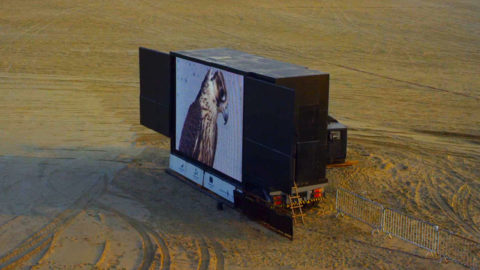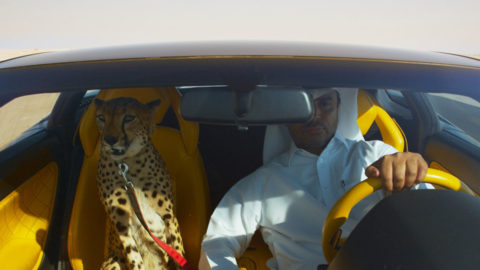Film of the Week: The Challenge
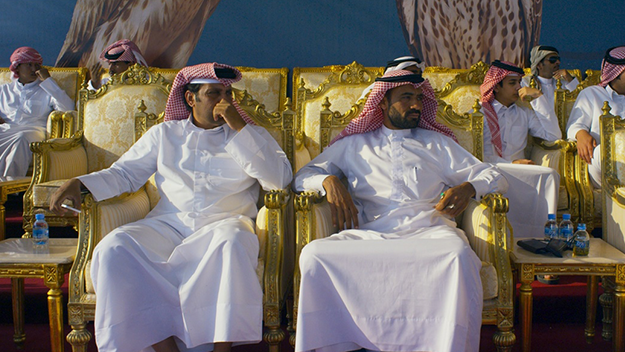
Yuri Ancarani’s The Challenge brings alive a phrase that you normally think of as being simply a conventional pairing of words: “fabulous wealth.” This strange documentary, if that’s what it is, makes you think that wealth genuinely can be fabulous, i.e. the stuff of fable, of fairy tale—that it can change the real world in ways that seem altogether alchemical. “Alchemical” in that the wealth on display in The Challenge seems to turn the base matter of reality into gold. And gold—both the material and the color—is something we see a lot of here.
For some time into The Challenge, I genuinely had no idea what I was watching: coming it across it sight unseen last year, I wasn’t aware that I’d be watching the record of a falconry contest in Qatar. The opening shots certainly don’t seem to announce a documentary. After several close-ups of a man looking upward at something, we see a long single take of a vast hangar, huge enough for an aerodrome, in which what seem like hundreds of birds are flying around freely. We hear the lush orchestrations of Lorenzo Senni and Francesco Fantini’s score: strings, playful flute, clicking percussion and then, once the credits start, momentous ceremonial fanfares. The image is composed in perfect symmetry, and it’s almost as if—in what’s effectively an overture to the film—curtains have been opened on an enormous stage, the setting for some bizarre ceremony.
Just as odd is the appearance of a tall pillar, a slab of blackness standing amid sand dunes, resembling the 2001 monolith, then the sight of a group of denimed and helmeted bikers riding across a stark desert—and can that really be a gold Harley-Davidson that the leader is riding? Then comes the killer image: a man in white robes climbs into a Lamborghini and takes off across the desert. Sitting placidly beside him in the passenger seat—a cheetah.
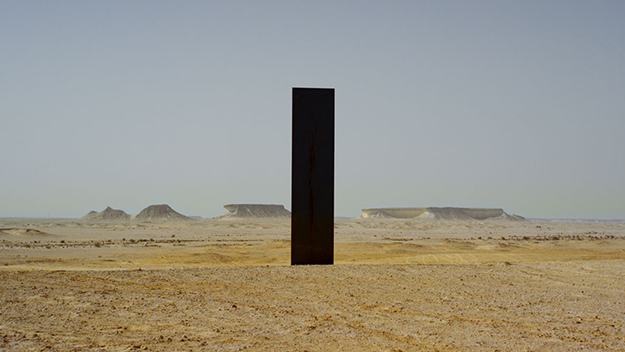
Birds, beasts, cars, bikes, and the men who ride them—this bizarre combination of elements surely has to have been elaborately staged for our wonder and bafflement. It’s partly Ancarani’s foregrounding of symmetry, in shot after shot, and his fascination with sleek motor vehicles, that made me wonder whether The Challenge was something akin to the bizarre juxtapositions of Matthew Barney’s Cremaster series, where cars, bees, buffalo, architectural marvels, historical and mythical figures, and even Norman Mailer himself offered themselves as raw material for the artist’s meticulously artificed multi-media filmed collages.
It took a while to register with me that The Challenge is in fact a documentary, albeit a very peculiar one. The elegance of Jonathan Ricquebourg’s photography, which constantly emphasizes the strangeness of what we’re seeing—both through enhanced richness of color and through manifestly crafted compositions—suggests video art rather than documentary of any conventional kind. Indeed, Italian artist Ancarani generally shows his work in art venues (although The Challenge was premiered at last autumn’s Locarno Film Festival, where it won a Special Jury Prize). In addition, the lustrous perfection of just about every shot suggests a certain glossy school of magazine photojournalism—a touch of, if you like, Condé Nast Conceptual Traveler.
Ancarani shows us events over two days and the intervening night as various groups of men—mainly, it seems, wealthy sheikhs—congregate at the site of a Qatar falconry tournament. While the Lamborghini driver bombs towards the destination and the bikers (the Qatar chapter of the Hells Angels) glide there in slow motion, one man flies to the event in his private jet, accompanied by six of his falcons, each seated on its own perch. A close-up shows one bird turning its head in rapid staccato motion, as if following some elusive sound beyond the hood that it’s been fitted with (it’s a wonderfully perverse idea, falcons needing to fly by plane—just like a cheetah, the fastest creature on land, needing a ride in a luxury car).
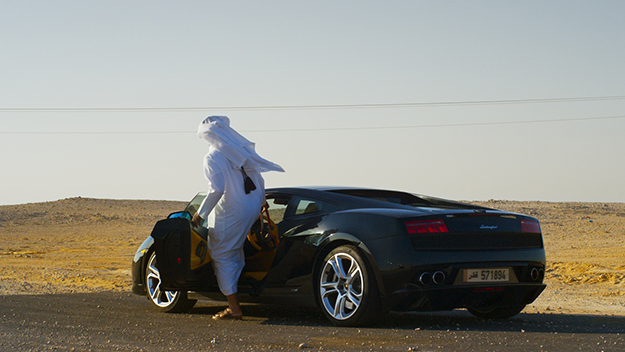
Much of the film is concerned with landscape, and the people in it. A rare camera move pans across a line of mesas, under cloudless blue sky. An aerial shot shows a knotty web of tire tracks on an expanse of desert; later, we see a line of monster trucks zigzagging into the distance; more than once, we see these trucks, charged with some kind of deluxe turbo fuel, surging up the sides of tall, seemingly vertical dunes. Ancarani doesn’t, as documentarists tend to at sporting events, cut away to small, “telling” details—a watching face, some briefly glimpsed event in the grandstands. Everything shown is lingered on, given its full weight and strangeness. One souped-up truck blasts flame from its exhaust pipe, firing at the sand beneath in machine-gun style; when it moves off, Ancarani shows the crater of fired earth that it has left. In another shot, the Angels dismount to pray in mid-desert, a muezzin’s call barely audible in the far distance.
Few words are spoken: two men watch a falcon auction live on TV and take part by phone; the cheetah’s owner amicably warns another man not to get too close to his pet: “She’s very dangerous and I don’t want to take you to hospital.” We also hear the words of the tournament commentator, over loudspeakers, cheering on favorite birds (“Go bird go!… It was God’s will!”), with what seems an undisguised partiality for certain falcons, or their owners. No individuals fully emerge, except perhaps the man in the plane, whose tenderness towards his birds is manifest, and the corsair-like leader of the Angels: otherwise, the film doesn’t get us near enough to distinguish between the many white-robed men gathered here and often seen from a distance.
What we do become aware of is the extraordinary affluence that seems to bind all these men—or most of them: perhaps not the falconer seen in close-ups grooming an anesthetized bird for the race, clipping its claws, polishing its beak (I assume this is pre-race grooming, rather than some form of taxidermy, although it certainly seems to turn the bird from a living creature into a thing).
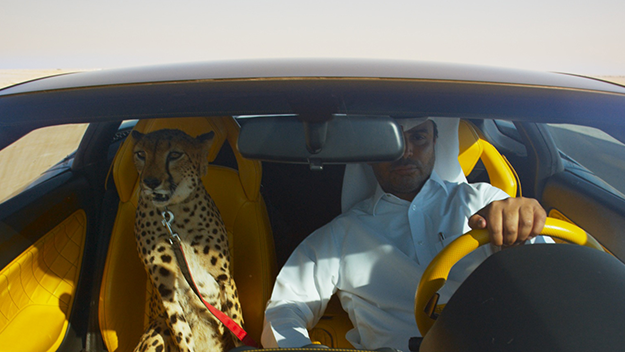
What’s remarkable about the look of the film is the way that it shows a world in which everything seems either made of gold—even the iPhones—or touched by it. The glints of sun as the bikers travel render the road itself gilded; the same rich yellow hues are pulled out of the spectrum in the close-ups of the rice and fatty roast lamb that supply a feast for one tentful of delegates. Sometimes the golden color emerges through contrast: a deep blue carpet enhances the yellow of the cheetah reclining on it, purring like a domestic pussycat.
Throughout, Ancarani exaggerates symmetries—shooting right down the aisle of the private jet, or from the roof of the speeding Lamborghini, or showing two men sitting side by side on a dune staring down at the cars below. This symmetry would seem to emphasize the strangeness of a world that will strike most viewers as profoundly strange already. But the further effect of the film’s singularly non-natural approach is to make everything seem that much more formal, suggesting that everything we’re seeing is part of a firmly established ritual—perhaps not a timeless one, given how much modern technology plays a part, but a regularly re-enacted ritual nonetheless. It’s as though what we’re watching is not a singular event—the 2016 tournament, let’s assume—but the tournament as it plays out, essentially the same, year after year.
Two sequences stand out as fundamentally different from the rest. The first time we see a set of faded video images linked by hyper-jerky cuts, it may take a moment before we realize we’re seeing footage captured with some sort of micro-camera attached to the falcons. Right at the end of the film, this technique lets us accompany a falcon through the air as it takes off after its pigeon prey, wheeling through the sky, high above the cars racing over the sand, sometimes swooping so low we think it’s going to crash, with the pigeon coming in and out of shot, seemingly forgotten (rest assured, though, the pigeon doesn’t have a chance).
I hadn’t previously heard of Ancarani, whose other films include a trilogy dealing respectively with the Carrara marble quarry, scuba divers and a surgical robot, and Séance, about an architect’s house; formalism and symmetry are seemingly central to his view of the world. On The Challenge, he has a superb DP in cinematographer Jonathan Ricquebourg, who established himself last year as a name to watch with this, Albert Serra’s The Death of Louis XIV and Maud Alpi’s Coeur gorge ventre (aka Still Life), an extraordinary poetic fiction set in a slaughterhouse. The other two films are intensely claustrophobic, each establishing rigorously closed spaces (you can practically breathe their stale air), but The Challenge too, though most of it is shot outside, establishes its own closed, highly formalized zone of action. It’s hard to say whether this is an unusually sheened documentary, an art piece that uses aspects of the real and transforms them radically, or a highly formal visual poem. But it’s a strange and beautiful thing: to use that word again, fabulous indeed.
The Challenge screens on March 16 and 19 in New Directors / New Films at the Film Society of Lincoln Center and the Museum of Modern Art.
Jonathan Romney is a contributing editor to Film Comment and writes its Film of the Week column. He is a member of the London Film Critics Circle.



